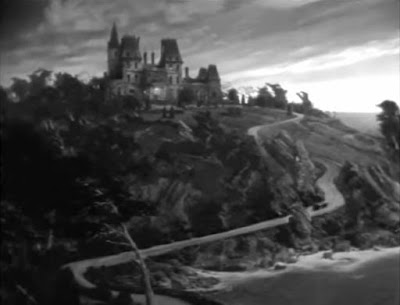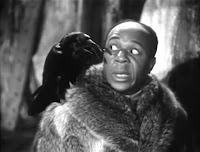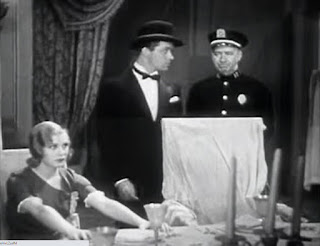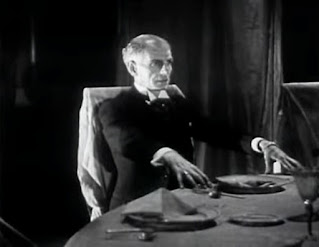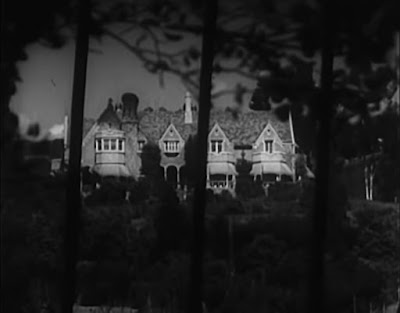30/09/2020
Topper Returns
24/09/2020
Black Actors in Old Dark House Movies
Elsewhere on this website, I've suggested that some of the elements of classic Old Dark House films grow from their predecessors in popular entertainment: horror imagery from early silent film, for example, mystery from Gothic fiction, and humour from vaudeville. A far more problematic inheritance, however, is the genre's portrayal of Black people - at best, as one-dimensional stock characters; at worst, the target of demeaning jokes made by white people.
Just as there's no way to ignore these portrayals, there's no way to defend or excuse them. They appear in such early efforts as 1922's The Ghost Breaker, become particularly prevalent in the genre in the early 1940s, and their influence continues to be felt today. As a result, while some viewers consider the old-fashioned Old Dark House a cosy and safe space to visit, others will feel excluded or insulted.
Only you can work out where your own line is drawn when it comes to viewing these films as entertainment. My own view is that modern-day genre fans should learn about the history and power of racist stereotypes from sources like Black Horror Movies, the Jim Crow Museum and Black-face.com. While acknowledging the extremely limited stage on which Black actors played in classic Hollywood, Looming Heirs! hopes to honour their accomplishments within an industry where they had little-to-no power.
For a rare example of an Old Dark House film made with an all-Black cast outside of the mainstream studio system (and therefore subject to the different limitations of being classed as a race film) see 1940's Son of Ingagi.
Willie Best (1916-1962) arrived in Hollywood as a chauffeur, a role he also played in his first Old Dark House movie, 1932's The Monster Walks, in which he was credited under the stage name Sleep n' Eat. While the film gave him the distinction of speaking the final line, this was unfortunately a racist joke about the monster ape of the title ("I had a grandpappy that looked something like him, but he wasn't as active"). Best was held in high regard by Bob Hope, his co-star in The Ghost Breakers (1940), who called him "the greatest actor I know". He went on to play similar roles in The Smiling Ghost (1941, above), The Hidden Hand (1941) and Whispering Ghosts (1942). The Mississippi Encyclopedia quotes an interview in which he reflects on his career: "I often think about these roles I have to play. Most of them are pretty broad. Sometimes I tell the director and he cuts out the real bad parts. But what’s an actor going to do? Either you do it or get out."
Mantan Moreland (1902-1973) is most famous for playing Charlie Chan's driver, Birmingham Brown, in fifteen films from from 1944 to 1949. Several of these qualify as Old Dark House movies, including Charlie Chan in the Secret Service (1944), Black Magic (1944) and The Jade Mask (1945). Much of Mantan's role in these films amounted to scaredy-cat pratfalls, a holdover from his performances in the earlier horror-comedies, King of the Zombies (1941, above) and Revenge of the Zombies (1943). Interviewed in The Afro American on 9 May 1959, however, he said: "The movies are growing up and I think my characterizations should keep pace with the times. Why shouldn't the role be written so that I solve the murder sometime? At least let me be cast as a little smarter than I have been heretofore."
Ernie Morrison (1912-1989), billed as 'Sunshine' Sammy Morrison, played Scruno, one of the otherwise white East Side Kids, in two Old Dark House comedies, Spooks Run Wild (1941) and Ghosts on the Loose (1943, above). While all of the gang get similar screen time, Black Horror Movies notes: "Scruno’s fidgety, hunched over, wide-eyed/mouthed character seems, well, just a bit more over-the-top. Plus, he’s the butt of several jokes about no one being able to see him in the dark, and when a white guy gets car exhaust blown in his face, one of the 'kids' yells, 'Hey, it’s Scruno’s uncle!'" After a busy career as a young actor, Morrison quit the movie business to work in the aerospace industry.
17/09/2020
The Thirteenth Guest
Joseph Stefano did it in PSYCHO... Kevin Williamson did it in SCREAM... But screenwriter Frances Hyland bumped off her leading lady even earlier in the 1932 horror-mystery, THE THIRTEENTH GUEST!
It's my custom to begin these reviews with a little look at the exterior of the Old Dark House in question but, as you can see from the still above, this is one of those annoying cases where it's never really shown. This is about as much as the film provides, glimpsed right at the start.
But what a start! A taxi pulls up late one night at 'the Old Morgan Place' on Old Mill Road and out steps Marie Morgan (a young Ginger Rogers). She's been lured to the former family homestead on her 21st birthday - which also happens to be the thirteenth anniversary of a dreadful dinner party during which her father not only announced some strange changes to his will, but also dropped dead. What strange changes, you ask? Well, he provided for his wife and immediate family, naturally, but the bulk of his fortune was destined for the party's mysterious 'thirteenth guest' - someone who never actually arrived and whose identity remains unknown. The house has been shut up ever since.
Back in the present, Marie finds, oddly, the electricity switched on and a new telephone installed in the otherwise derelict and cobweb-choked property, along with an envelope addressed to her. The note inside reads: 13 - 13 - 13. She hears a noise, goes to investigate; we hear a scream, a gunshot... and the next thing we know is Captain Ryan of the local police force is phoning his friend, private investigator Phil Winston, with the promise of a 'really good murder' to solve...
And, wowee, yes - this one does turn out to be a pretty good case! Not so much the outcome (the final revelation is actually a bit of a let-down) but the journey there involves a roster of suspects who've grown bitchier with each year since their fateful gathering, plus secret passages, a fairly inventive murder weapon and a howling, hooded villain. On top of that, this already quite slasherific killer also likes to pose their victims' bodies around the original dinner table in a Tableau of Death™, a trope that became a slasher film standard fifty years later:
The script finds an excuse to bring Ginger Rogers back after her early exit - a wise decision because she's a lot of fun. The same goes for Lyle Talbot, on a major smarm offensive as the unapologetically sleazy detective, Winston. (This lively duo reunited the following year for another mystery, A Shriek in the Night, also written by Frances Hyland.) Winston's amorous antics, along with some clanging double entendres, make it pretty obvious this one's pre-Code, but there's some surprising shading around two male characters presented as being in a relationship. (A police officer even refers to one as the other's 'boyfriend'.)
If there is a weakness it's that aforementioned climactic reveal but, coming off the back of some strong suspense and ingenious plotting, I say ignore the black fly and down the chardonnay... It's not always this sweet.
RATING: 🕸🕸🕸
13/09/2020
The Three Weird Sisters
THREE creepy dowagers cook up at least FOUR murder attempts in ONE weird film... It's the 1948 proto-psycho-biddy movie, THE THREE WEIRD SISTERS! And it's Welsh.
I'm genuinely not sure at this point whether having Dylan Thomas co-write the script for your Old Dark House movie is a good idea. On the one hand, this is a more-than-usually clever piece, complete with lyrical turns of phrase and savage deconstructions of Welsh identity; on the other, it's peppered with scenes and conversations that feel like they belong in a different film, and begins a complex exploration of philanthropy and class responsibility that it can't possibly hope to resolve within its scant running-time.
Let's take the basic scenario for starters: the elderly, Victorian-valued Morgan-Vaughan sisters - Gertrude, Maude and Isobel - preside over the mining town of Cwmglas, which has just suffered a disaster in the form of a pit collapse that's left an entire street in ruins. Gertrude and the gang want to take responsibility and offer financial aid - but their London-based brother, the obnoxious Owen (a step-sibling but, as a man, the one who's naturally in charge of the family fortunes), is having none of it. Intending to put his foot down once and for all, he decides to pay his sisters a visit, dragging along secretary Miss Prentiss for backup. But, before you can say 'mysterious stomach upset' and 'no more trains tonight', the city folk are trapped at the sisters' gloomy mansion until morning...
You can probably see where this is going. It's no spoiler that the sinister spinsters are out to prune Owen from the family tree, diverting control of the finances to themselves. And, yes, they're puritanical, curmudgeonly and clearly the villains of the piece... but are they really? After all, they want the money to support the beleaguered townsfolk, while boorish Owen simply wants to keep it (and all control) to himself.
Everyone's motives do eventually receive some further shading: Dylan Thomas apparently invests something of himself in Owen, who it turns out has had to work hard to escape the pressures of his old-fashioned, backward-looking clan, and at one point mounts a frankly astonishing condemnation of his home country ("Slag heaps and pit heads and vile black hills... How vile was my valley!"). And through those odd little diversions into local scenery, we see some of the damage wrought on 'the workers' and their lives by their land-owning masters, who've pushed the mines to literal breaking-point.
These are weighty themes and, to be honest, the film frequently drops them with a clang in favour of exploiting its more macabre possibilities, such as the string of murder attempts that make up most of its plot. The unwitting Owen comes under threat from poisoned sherry...
Plummeting clocks...
Mysteriously missing road signs...
And a build-up of lethal coke fumes...
...before eventually coming up with a counter-scheme that neatly removes him from the equation, but not without inadvertently(?) putting his secretary in the deadly trio's line of fire! It's here - in, admittedly, the more traditional woman-in-peril moments - that the film is at its most successful. Nova Pilbeam, as the capable and outspoken Miss Prentiss, genuinely shines, making it clear why Hitchcock chose to work with her on both The Man Who Knew Too Much (1934) and Young and Innocent (1937).
The Three Weird Sisters makes for a suspenseful and unpredictable experience, and even if, at the end of the ride, it seems content to just coast into the station, you can't say it hasn't been a bit of a wild one. The revered farce Kind Hearts and Coronets would come along a year later, turning murderous succession into an art form, but given the choice I think I'd rather spend a night with the malicious Morgan-Vaughans.
RATING: 🕸🕸🕸
11/09/2020
Defining the Old Dark House Genre
What is an Old Dark House movie? A kind of mystery or horror film? Or just anything set in a big old house? And what's with all the comic relief?
I'm going to go out on a bit of a limb and suggest that horror is the key component here. Old Dark House films first took root in the silent film tradition - and many of the silent era's lasting images are those of terror. Think Nosferatu, Caligari, the violence of Battleship Potemkin and the uncanny robots of Metropolis. While the intricacies necessary for a truly satisfying murder mystery might be hard to convey within a silent movie, put a helpless victim in the foreground and a shadowy figure in the background, and you don't need sound to convey a feeling of fear.
08/09/2020
Lost Old Dark House Films
With three-quarters of all silent films thought to be lost, according to the Library of Congress, it's inevitable that a number of Old Dark House movies would count among these. Future discoveries may yet be made; indeed, 1932's The Old Dark House was itself believed lost for almost forty years until a print turned up in a studio vault. But, as time ticks on, it looks like all that's left of the following films are photographs, snippets and memories.
The Ghost Breaker (1914) was possibly the first filming of an Old Dark House story, directed by none other than Cecil B. DeMille, who also had a hand in the script (based on Paul Dickey and Charles W. Goddard's 1909 play, which was first staged in 1913). The story, concerning a spooky castle left to an unsuspecting heir, has been filmed multiple times, with the quintessential version perhaps being 1940's The Ghost Breakers.
The Circular Staircase (1915) adapted the popular 1908 novel by Mary Roberts Rinehart. A full synopsis and contemporary review quotes are given in the book American Silent Horror, Science Fiction and Fantasy Feature Films, 1913-1929 by John T. Soister, Henry Nicolella and Steve Joyce. Print ads from the time read: "There was a shot in the night and two dead bodies lay huddled in the shadows at the foot of 'The Circular Staircase' before threads of fate were finally unravelled."
Seven Keys to Baldpate (1916) was an Australian silent movie, closer to a filmed version of George M. Cohan's stage play of the same name, recorded against canvas sets at the Theatre Royal, Melbourne. Three of its four reels survive.
The Ghost Breaker (1922) again used Paul Dickey and Charles W. Goddard's play as its basis. Lots of lobby cards are still in existence and can be seen as part of a thorough overview of the film at the Lost Media Wiki.
London After Midnight (1927), starring Lon Chaney, is one of the most famous lost films of all time and, as such, there's tons of information available about it on Wikipedia. Director Tod Browning remade it in 1935 as Mark of the Vampire, and TCM created a reconstruction using stills in 2002.
The House of Horror (1929) came from Danish director Benjamin Christensen, and was another Old Dark House film with a soundtrack in the form of an accompanying Vitaphone record of music and sound effects. Michael R. Pitts' book, Thrills Untapped: Neglected Horror, Science Fiction and Fantasy Films, 1928-1936, provides a full synopsis and quotes from critics, and there's more at Vitaphone Varieties.
The Cat Creeps (1930) was a sound remake of 1927's The Cat and the Canary, from which the only remaining footage is incorporated into a 10-minute short film from Universal Pictures called Boo! (1932). As with Universal's 1931 film of Dracula, a Spanish version called La Voluntad del Muerto (The Will of the Dead Man) was filmed using the same sets but this is also lost. Both are thankfully discussed in some detail over at Movies and Mania.
The Gorilla (1930) was based on Ralph Spence's play and, like the same year's The Cat Creeps, came with a Vitaphone soundtrack record. The Lost Media Wiki again has a lovely write-up, including a 28-second clip that turned up in 2003.
Castle Sinister (1932) was a British horror film that just preceded the Boris Karloff-starring The Ghoul. Thanks to the research of Mark Fryers at The Spooky Isles, we have a full description.
Sources: As well as from the articles sited, this information draws on the various films' Wikipedia articles, and uses images from Wikimedia Commons.
05/09/2020
The House of Secrets
Who are the secretive strangers holding secret meetings at Hawks Nest Manor? What secret treasure is secreted within its walls? Welcome to THE HOUSE OF SECRETS, where everything is a BIG, FAT SECRET!
Being kept in the dark is part and parcel of enjoying a good mystery story, but it's usually carried off with just a little more finesse than in this 1936 effort, where characters flat-out refuse to explain anything, while repeatedly explaining that they can't explain anything. Ever.
No sooner has ferry passenger Barry Wilding (played by a slightly smarmy but still likeable Leslie Fenton) made the acquaintance of a mystery woman (Muriel Evans) than she's coming out with mysterious things like, "I can't explain, but you're an American and I'm an American and that's all we can ever know about each other!" A bit dramatic, perhaps - as is tossing her own handbag into the English Channel in case he grabs it and reads the name on her Boots loyalty card - but it's that kind of movie...
The kind of movie where Barry finds out, as soon as he arrives in London, that he's inherited the Trevelyan family estate, Hawks Nest, left to him by a 'barmy' uncle and requiring him to sign the deeds - in blood! - beneath a clause that reads, "By ye blood that cometh from my heart, I swear to keep Hawks Nest till death do us part."
And that could be sooner than Barry might like, since, when he gets to the manor (a spiffy fifteen miles from London) he discovers a ragtag bunch of ne'er-do-wells who'd like nothing better than to see the back of him... preferably with several bullets in it. There's shady scientists, Chicago gangsters, the mystery woman from the boat, unsympathetic police officers, and even the Home Secretary himself. What the bliddy heck is going on?
Well, it's a while before you really find out - and, to be honest, you'll probably have cooked up some more interesting theories of your own in the meantime - but it's mostly good fun, with things picking up considerably following the introduction of the secret-treasure subplot (which arrives, like most things, out of thin air). The gangsters have somehow obtained a torn piece of parchment containing clues to the loot's whereabouts and, oh, Barry has the other half. If everyone could manage to stop wandering the estate bumping into each other in the dark for five minutes, they might even be able to piece things together and discover a secret passage!
If as much care and attention had gone into the plot as the set designers put into this secret chamber, we might have been onto something. As it is, The House of Secrets is a bit of a mixture, to put it kindly, of plot elements, tone and British and American influences. The humour is thankfully on the subtle side, with wisecracks in the style of The Cat and the Canary bringing warmth to most of the characters (except poor Muriel Evans, who gets nothing even remotely fun to do).
The designers do seem to be having fun with the sets and overall look of the film - not only the aforementioned hidden dungeon but some exaggerated window views outside the offices in the London scenes, and some great vintage stock footage of Piccadilly Circus. There's also a lovely camera glide between two rooms of Scotland Yard, sneaking 'impossibly' through a wall in a delightful throwaway moment very much in the movie's style.
Is it a genuine Old Dark House film? There's perhaps not quite enough time spent in the house itself, despite vivid themes around inheritance, mysterious guests and, of course, secret-passage peril. But the sense of intrigue is strong, if a tad frustrating at times, and it's a fairly brisk and inoffensive affair, which should appeal to Old Dark House fans and wider mystery buffs equally.
RATING: 🕸🕸
